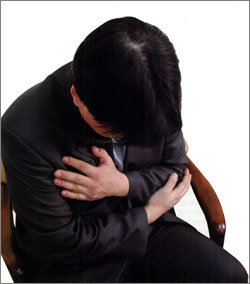Shingles Often Mistaken For Muscular Pain
Shingles Often Mistaken For Muscular Pain
Posted March. 27, 2005 23:31,

Shingles is a skin disease that brings a breakout of several ring shaped blisters. The character of this illness is that the symptoms are difficult to diagnose as a skin disease. In the incipient period, even doctors find it difficult to make a correct diagnosis.
The cause of shingles is identical to chickenpox, but it can reactivate-
The causal virus for shingles is called varicella-zoaster. It is the same virus that causes chickenpox in children aged between two and 10. Due to immunity, people dont get a chickenpox second time. However, people who have had chickenpox may have shingles. Over 90 percent of Korean people who are over 40 have the varicella-zoster virus inside their bodies regardless of their history of getting chickenpox. When people get old and infirm, they can have a weaker immune system due to their previous illnesses. Then, the dormant varicella-zoster viruses on the nerve cells reactivate and cause shingles.
Need to think about shingles if you have a pain on one side of your body-
Symptoms of shingles begin with a sharp needle-like pain rather than a skin problem. This is the reason why diagnosis is difficult for pre-eruption shingles. The most commonly reported pain spot is the chest, followed by waists, arms, and faces. Patients who suffer a slipped disc can misjudge that they have a done so a second time because of the pain.
When people have pain on one side, they need to think about the possibility of getting shingles. The virus travels along the path of nerves, so symptoms usually occur on one side of a body. The symptoms rarely break out on both sides of the body.
Some shingles patients suffer from headaches, stomachaches, or pain in the arms and legs. Others suffer fever and lethargy. Some also experience itching without blisters.
The virus moves along the sense nerves. Around five percent of patients experience viral attacks on their motor nerves, so they become unable to lift up their arms and legs.
Blisters need to be treated immediately-
Three to five days after the breakout of pain, fluid-filled blisters develop on the spot. It can take around 10 days for these blisters to develop. In the beginning, small blisters come out sparsely, but they form a shape of a band as getting closer. The blisters gradually become hard and form crusty scabs. The scabs usually fall off after one or two weeks.
No medicine can fight off the varicella-zoaster virus. However, an anti-virus shot within three to five days after the outbreak of blisters can get rid of the pain within a week. The rash also fades around two or three weeks after an outbreak. Nevertheless some patients can get neuralgia as a recurring symptom when they start treatment later than necessary or when they are too old.
Kidney patients should be heedful in measuring the proper dosage when they use anti-viral medicines. Some say, The pain that accompanies shingles is more serious than labor pains, so anodynes and antidepressants are sometimes used.
It is not contagious by physical contact. But, it can be easily transmitted to children, patients, and people who have never had chickenpox. Therefore, it is recommended to hospitalize and cure shingles patients separate from the general patient population
(References: Professor Lee Min-geol of the Dermatology Department at Severance Hospital, Professor Kim Won-seok of the Dermatology Department at Samsung Medical Center)
Please, contact health@donga.com if you have any further health questions.)
TK Sohn sohn@donga.com



![화장실 갇혔을 때 생존법…“최후에는 변기뚜껑” [알쓸톡]](https://dimg.donga.com/c/138/175/90/1/wps/NEWS/IMAGE/2025/12/26/133042007.3.png)



